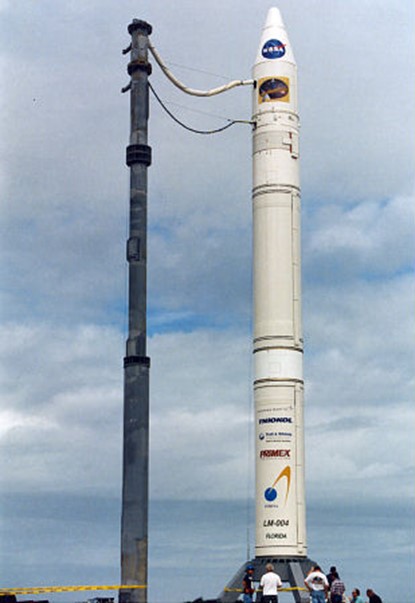ATHENA II FACT SHEET
By Cliff Lethbridge

Athena II Launch Preparations, Photo Courtesy NASA
Classification: Space Launch Vehicle
Length: 100 feet
Diameter: 7 feet, 9 inches
Date of First Cape Canaveral Launch: January 6, 1998
Date of Final Cape Canaveral Launch: January 6, 1998
Number of Cape Canaveral Launches: 1
The Lockheed Martin Athena II is a three-stage big brother of the Athena I. A single Thiokol Castor 120 solid rocket motor provided both first and second stage propulsion for the Athena II, with simply one of the solid rocket motors stacked above the other. Each Castor 120 solid rocket motor was 28 feet, 11 inches long by 7 feet, 9 inches wide. Each Castor 120 solid rocket motor burned Class 1.3 Hydroxyl-terminated polybutadiene (HTPB) solid propellant and could produce a thrust of 435,000 pounds. The solid rocket motors employed a composite casing, with exhaust nozzle steering provided by blowdown cold gas-powered hydraulic thrust vector control (TVC) actuators. The Athena II employed an Orbus 21D third stage manufactured by Pratt and Whitney Space Propulsion Operations, Chemical Systems Division. The third stage was 10 feet, 4 inches long by 7 feet, 8 inches wide and, like the Athena II lower stages, burned Class 1.3 HTPB solid fuel. The third stage could produce 43,723 pounds of thrust. It employed a composite casing, with steering provided by a carbon phenolic nozzle using electromechanical TVC actuators.
Following separation of the third stage, an Orbit Adjust Module (OAM) was ignited. The OAM housed an attitude control system and avionics subsystem, which incorporated guidance and navigation equipment, batteries, telemetry transmitters and command destruct receivers and antennas. A maximum load of 960 pounds of hydrazine liquid fuel powered the OAM attitude control system, which performed orbital injection corrections, roll control, velocity trim and orbit circularizing maneuvers. The OAM attitude control system was manufactured by Primex Technologies. Located directly beneath the payload itself, the OAM eventually separated from the payload and performed a contamination and collision avoidance maneuver until its hydrazine fuel is depleted. The maneuver was intended to protect the payload from any potential damage.
The Athena II offered two sizes of payload fairings and three sizes of payload adapters which could be interchanged to accommodate a number of different sized payloads. Utilizing what its manufacturer called a “stack and shoot” approach to launching payloads, the Athena II could be prepared for launch in just 30 days after its first stage arrived at the launch site. The rocket was capable of carrying a maximum 4,350-pound payload into low-Earth orbit or a maximum 3,200-pound payload into polar orbit. It was also capable of sending small payloads into interplanetary trajectory, as was proven by the Athena II launch of the NASA Lunar Prospector on January 6, 1998. The Lunar Prospector weighed 652 pounds and successfully achieved lunar orbit.


